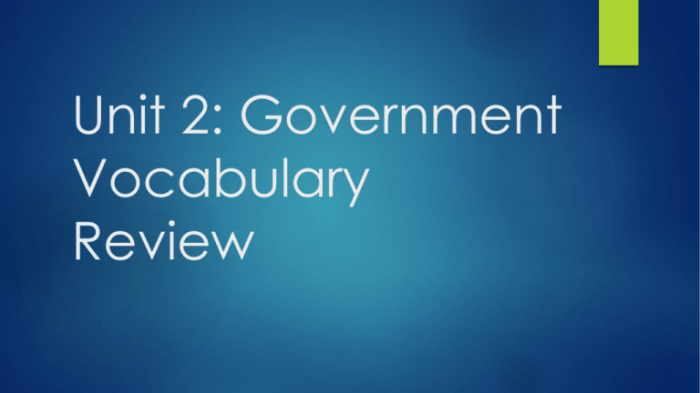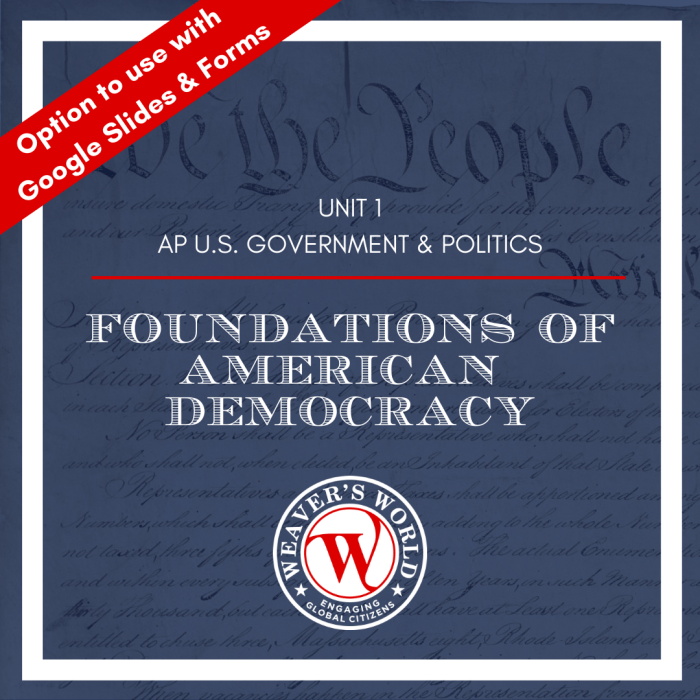Welcome to the world of AP Government Unit 1 Vocabulary! Embark on a journey through the fundamental principles that shape American governance. This guide will provide you with a comprehensive understanding of the concepts that underpin our political system, empowering you to navigate the complexities of our nation’s intricate political landscape.
Delve into the constitutional underpinnings, federal government structure, federalism, civil liberties, and political participation. Each section offers a wealth of knowledge, equipping you with the vocabulary and insights necessary to engage in informed discussions about American politics.
Constitutional Underpinnings of American Government

The U.S. Constitution establishes the fundamental principles that shape the structure and functioning of the American political system. These principles include popular sovereignty, limited government, and the separation of powers.
Popular Sovereignty
Popular sovereignty refers to the idea that the government derives its authority from the consent of the governed. This principle is reflected in the Constitution’s Preamble, which states that the Constitution is established “by the People of the United States.”
Popular sovereignty is also evident in the way that government officials are elected. The President, members of Congress, and state and local officials are all chosen through elections in which citizens have the opportunity to vote for the candidates of their choice.
Limited Government
Limited government refers to the idea that the government’s power is not absolute. The Constitution establishes limits on the government’s power through a system of checks and balances.
The system of checks and balances ensures that no one branch of government can become too powerful. For example, the President can veto laws passed by Congress, but Congress can override the President’s veto with a two-thirds vote.
Separation of Powers
The separation of powers refers to the idea that the government’s power is divided among three branches: the legislative, executive, and judicial branches.
The legislative branch is responsible for making laws. The executive branch is responsible for enforcing laws. The judicial branch is responsible for interpreting laws.
The separation of powers helps to prevent any one branch of government from becoming too powerful.
Structure of the Federal Government: Ap Government Unit 1 Vocab
The United States government is a complex system of checks and balances designed to ensure that no one branch becomes too powerful. It is divided into three branches: legislative, executive, and judicial.Each branch has its own specific powers and responsibilities.
As you delve into the intricacies of AP Government Unit 1 vocab, it’s crucial to understand the complexities of historical figures like John Adams. While he played a pivotal role in shaping our nation, it’s also important to acknowledge the bad things he did . By examining both his positive and negative actions, we gain a more nuanced understanding of his legacy.
Returning to AP Government Unit 1 vocab, it becomes evident how these concepts intertwine, shaping the political landscape of the United States.
The legislative branch, consisting of the Senate and the House of Representatives, makes laws. The executive branch, led by the President, enforces laws. The judicial branch, consisting of the Supreme Court and lower courts, interprets laws.
System of Checks and Balances
The system of checks and balances prevents any one branch from dominating the others. For example, the President can veto laws passed by Congress, but Congress can override a veto with a two-thirds vote. The Supreme Court can declare laws passed by Congress unconstitutional, but Congress can amend the Constitution to overrule the Court.
Table of Key Features and Functions, Ap government unit 1 vocab
| Branch | Key Features | Functions ||—|—|—|| Legislative | Makes laws | Passes bills, overrides vetoes || Executive | Enforces laws | Executes laws, vetoes bills || Judicial | Interprets laws | Declares laws unconstitutional, reviews cases |
Federalism and the Distribution of Power
Federalism is a system of government in which power is divided between a central authority and constituent political units (states or provinces). In the United States, federalism is established by the Constitution, which divides power between the national government and the state governments.
The Constitution establishes three main categories of powers:
- Exclusive powersare those that only the national government can exercise, such as regulating interstate commerce, declaring war, and printing money.
- Concurrent powersare those that both the national government and the state governments can exercise, such as taxing, regulating commerce within their borders, and establishing courts.
- Reserved powersare those that are not specifically delegated to the national government or prohibited to the states, and are thus reserved to the states, such as education, public health, and welfare.
Mechanisms for Resolving Conflicts
The Constitution provides several mechanisms for resolving conflicts between the national government and the state governments.
- The Supremacy Clauseestablishes that the Constitution and laws made pursuant to it are the supreme law of the land, and that state laws that conflict with federal laws are invalid.
- The Commerce Clausegives Congress the power to regulate interstate commerce, and has been interpreted broadly to give the national government a great deal of power over the economy.
- The Necessary and Proper Clausegives Congress the power to make all laws that are “necessary and proper” to carry out its enumerated powers.
- The Tenth Amendmentreserves all powers not delegated to the national government or prohibited to the states to the states or the people.
Civil Liberties and the Bill of Rights

Civil liberties are fundamental freedoms and protections guaranteed to individuals by the Constitution and the Bill of Rights. They are essential in a democratic society to ensure that citizens are free from government overreach and can exercise their rights without fear of persecution.The
Bill of Rights, the first ten amendments to the Constitution, enshrines these civil liberties, including freedom of speech, religion, assembly, and the right to a fair trial. These provisions protect individuals from arbitrary government actions and guarantee their fundamental rights.
Historical Development of Civil Liberties
The concept of civil liberties has evolved over time, with significant milestones in American history shaping their interpretation and application. The Declaration of Independence and the Constitution established the principles of individual rights and limited government. However, it was not until the adoption of the Bill of Rights that these rights were explicitly enumerated and protected.
Ongoing Debates
The interpretation and application of civil liberties have been subject to ongoing debates throughout American history. Landmark Supreme Court cases, such as those involving freedom of speech and religious expression, have shaped the boundaries of these rights. These debates continue today, as society grapples with balancing individual freedoms with the need for public safety and order.
Political Participation and Representation
Political participation and representation are crucial aspects of a democratic society, allowing citizens to engage in the political process and have their voices heard. This section will explore the different forms of political participation, the importance of representation, and the challenges faced in ensuring fair and equitable participation for all.
Forms of Political Participation
Political participation takes various forms, each contributing to the functioning of a democratic system:
- Voting:Casting a ballot in elections is a fundamental form of political participation, allowing citizens to choose their representatives and influence policy decisions.
- Running for office:Individuals can directly participate in the political process by running for elected positions, representing their constituents’ interests.
- Joining political organizations:Joining political parties, interest groups, or other organizations allows individuals to engage with like-minded people and advocate for specific causes.
Importance of Political Representation
Fair and equitable representation is essential for a responsive and accountable government. Mechanisms such as redistricting and electoral systems are used to ensure that all citizens have an equal opportunity to elect representatives who reflect their interests:
- Redistricting:The process of redrawing electoral districts to ensure equal representation of population groups.
- Electoral systems:Different systems, such as first-past-the-post or proportional representation, can impact the fairness and inclusiveness of representation.
Challenges to Political Participation and Representation
Despite the importance of political participation and representation, several challenges exist, particularly for marginalized groups:
- Voter suppression:Efforts to restrict access to voting, such as voter ID laws or limited polling places, can disproportionately affect marginalized communities.
- Gerrymandering:The manipulation of electoral districts to favor a particular party or candidate, diluting the representation of certain groups.
- Underrepresentation:Historical and systemic barriers have led to the underrepresentation of women, minorities, and LGBTQ+ individuals in political office.
FAQ Summary
What is the significance of popular sovereignty in American government?
Popular sovereignty is the principle that the government derives its authority from the consent of the governed. It empowers citizens to shape their political system through elections and other forms of participation.
How does the system of checks and balances prevent any one branch of government from becoming too powerful?
The system of checks and balances ensures that no single branch can dominate the others. Each branch possesses powers that can limit the actions of the other branches, creating a balance of power that safeguards against tyranny.
What are the key provisions of the Bill of Rights?
The Bill of Rights comprises the first ten amendments to the U.S. Constitution. It protects fundamental freedoms such as freedom of speech, religion, assembly, and due process of law, ensuring the rights of individuals against government encroachment.